Starhawk's Blog, page 5
August 1, 2011
Lammas Blessings and Gratitude
Lammas morning—I woke up and saw that during the night we'd reached our first funding point on our Kickstarter campaign for The Fifth Sacred Thing movie. Yesterday, I'd posted the update below on our Kickstarter page—hoping that we'd hit that landmark on Lammas, and we did! Such good magic!
"August 1, Lammas, one of the eight key Celtic Pagan holidays on the Wheel of the Year. Lammas, traditionally, was the beginning of the harvest, when the early crops are coming in and the summer fruits are ripe. In Ireland, it was Lughnasad, the festival of the sun-God Lugh. "Lammas" comes from "Loaf-mass"—the loaf made from the first-harvested grain. It was a time of fairs and feasts, of hopes and fears, when the grain is ripening in the fields but not yet brought into the barn.
"Here in northern California, Lammas generally marks the beginning of the driest, most dangerous time of the year. We are midway through our long dry season, with all the moisture burned out of the grasses and the trees beginning to thirst. A spark, a careless cigarette butt, a bottle of water left in the field that serves as a magnifying glass can start a fire that will rage over thousands of acres. Water tanks are running low, springs dry to a trickle, and rain is still weeks away.
"For that reason, I chose Lammas as the date of the Uprising, and its anniversary, in The Fifth Sacred Thing book. "In the dry time of year, the dangerous time, the risk time, an old woman climbed a hill…" so begins the story. "Like most people in the southern part of the city, she called the season El Tiempo de la Segadora, the Time of the Reaper. The hills were dry, the gardens dependent on the dwindling waters of cisterns, the rains still weeks away. A time of ripening, but not yet of harvesting, when nothing was certain."
"Incidentally, I was originally going to call the novel The Time of the Reaper. Bantam thought that sounded too much like a Gothic novel or horror film, and someone in their editorial offices suggested The Fifth Sacred Thing. Thank you!
"As I look at Kickstarter today, I realize we may well reach our first funding point on Lammas—or very shortly thereafter. A first harvest, indeed!
"Lammas is also a time for gratitude, and I am deeply thankful for all the wonderful support we have been receiving in so many ways. The movie is far, far from its ultimate harvest point, and our funding point on Kickstarter, we hope, will not be an end point but an important marker—and a moment of huge relief as after that, we know that we will actually be getting all the funds that people pledge! But what a powerful first harvest! Thank you all so much for being part of this wonderful adventure! May your own harvests be abundant and your endeavors yield sweet fruit!"
No one was up at my house when I saw the good news, except for fifteen-year-old Kore who was subjected to a sequence of ecstatic hugs and eventually fled to go rouse the parents. I called my good friend Donna—good news needs to be shared!
"Well, now you must really be terrified," she said.
"I was," I admitted. "But fortunately our Lammas ritual this weekend focused a lot on letting go of the things that get in the way of your dreams."
I should say that I had nothing to do with planning the ritual. That's the wonderful part of collaborative organizations—in Reclaiming, over the years, I've been able to step back from many roles and let other people take them on. The gift is that you often get something you don't expect. Were I planning the ritual, I probably would have focused on something different. But for me, having a chance in ritual space to connect with a few people to share our dreams and name what might keep us from them, and consciously let go of the outcome—oooo, I resisted that, but it was good for me.
I don't let go of the sense of responsibility I feel—to all the people who have given their support and good will and hard-earned money to this project. I feel a great determination to do all that's within my power—and perhaps a bit beyond—to make it the movie, and the larger project, that can help propel us into the positive vision of the future we want.
But there are many things beyond my control that could get in the way. The most likely being that the Republicans and Democrats between them will utterly destroy the economy in the next week. A tsumani could wash away San Francisco. Another earthquake could hit. A giant asteroid could crash into the earth. The rapture might actually happen this October. The sun could burn out way ahead of schedule. We could make the movie and everyone could hate it.
So…take a deep breath, and instead of focusing on the worries, let go of the outcome. Move ahead without fear, but with joy and gratitude. Enjoy the harvest as it comes in.
We will continue to raise money—it's amazing the amount of money it takes to put together the proposal for the investors whom we hope will provide the next tier. But now we know we can move ahead with some key facets of the project, and that we have some resources to lay on the table. Thanks to all who have been supporting us in so many ways.
And great gratitude to the Reclaiming ritual planners, and to all who offer ceremonies and spiritual support to your communities.
A blessed Lammas to you all!
Reclaiming has groups in many areas who offer rituals, classes, and camps:
Website for The Fifth Sacred Thing movie:
http://fifthsacredthing.com/home/
Kickstarter Page:
http://www.kickstarter.com/projects/fifthsacredthing/the-fifth-sacred-thing
Facebook for the Film:
http://www.facebook.com/TheFifthSacredThingFilm
Facebook for the book:
http://www.facebook.com/pages/The-Fifth-Sacred-Thing/109374575747760?ref=ts&sk=info
Starhawk's Website:
Fifth Sacred Thing Book:
July 28, 2011
On the Murders in Norway: The Need for a Multicultural Vision
This summer has been a whirlwind of teaching permaculture and working on making a movie from my novel, The Fifth Sacred Thing. But a few days ago I took a break to attend a performance of Guys and Dolls put on by SF Arts Education, in which my fifteen-year old Goddess-child Kore was singing and dancing. SF Arts Ed runs a wonderful program where students from middle schools and high schools put on Broadway musicals, complete with singing, dancing, and a full jazz orchestra. We had balcony seats behind the stage, so I was looking down on these bright and beautiful young people of all different backgrounds and ancestry, reflecting the multicultural nature of San Francisco itself. They are a talented bunch, but I also know how hard they work, how much time they rehearse and the discipline they develop. What a gift it is to have such wonderful youth growing up in our city!
Weighing on my mind were the terrible murders in Norway, where Anders Behring Breivik blew up government buildings and then went on a shooting rampage at a camp full of young people. His avowed intention was to somehow defend the purity of Norwegian and Christian culture against Moslems and others who in his mind are undesirable. He apparently fantasized himself as some sort of modern-day crusader.
Breivik is clearly insane—meaning, far off the spectrum of consensus reality. Unfortunately, there are many others who share his views if not his eagerness to commit mass murder. When news of the bombing first surfaced, the media leapt to the conclusion that Muslims had done it. Racist commentators bleat their poison over the airwaves daily, and solemn pundits intone that somehow in Europe, 'multiculturalism has failed.'
I was pondering all this, watching the wonderful dancing and the songs from a day when multiculturalism meant Jewish gangsters on Broadway encountering Salvation Army missionaries. A Broadway musical, I thought, must be the most quintessential American art form, if there is such a thing. I considered whether these youth whose ancestors came from Europe, African, China, Japan, Central and South America, the Pacific Islands, India, and probably some other places I haven't listed might not benefit from doing something more 'multicultural'—the Ramayana with African drums, perhaps, or Ntozake Shange's play For Colored Girls Who Have Committed Suicide When the Rainbow was Enough.
But the jazzy music caught me up in pure enjoyment. And then suddenly it struck me—Guys and Dolls is multicultural. Along with every other Broadway musical, as well as jazz, gospel, blues and rock & roll, it owes as much to Africa as to Europe in the rhythms and patterns of its music. That fabulous tap dancing started as Irish clogging way back when. The form of storytelling with music and dance goes back as far as humankind recounting the hunt around the communal fire.
"Western culture" itself is multicultural. Breivik blew up his buildings with explosives invented in China. He counted his dead in Arabic numerals.
The media is full of strident voices telling us greed and prejudice and self-righteous, self-justifying bile are not only okay, they're patriotic! Breivik's horrific murders were a clear message about where that thinking leads—to the death of innocents.
We need strong voices now to raise up a powerful countercry, to say that all of us have value, that we're here on earth to take care of one another, to proclaim that every difference of background and culture and perspective is a gift. We need a vision of how we might live in such a world—for if we can't imagine it, how can we create it?
That's why I've thrown myself so deeply into the project of making my novel, The Fifth Sacred Thing, into a movie. In the book, I envisioned a society that truly valued diversity. It's one vision—not the only vision—of how ideals of justice might play out, and the huge support we're receiving for the project shows how hungry people are for a positive vision of a future here on earth.
But truly, I don't just want to make a movie. I want to make a different world. The movie is a vehicle toward that end—one vehicle, maybe not the best but the one that seems to lie before me right now. I'm enormously grateful for all the help and support we've been finding along the way. But I don't want people to wait for the movie. Now, today, do something to nourish and strengthen your own vision. Now, today, do something to counter the voices of hate and greed and doom. Every heritage includes great beauty and great pain, and we will need to draw on the wisdom and experience of all of them to weather the storms ahead. Shout out the truth—that we all count. We are interconnected, interdependent, and when we get good at it, a multiplicity of rhythms will move our feet in a joyous dance, and a chorus of voices harmonize in exultant song.
Some simple things to do:
Pat Buchanan, on MSNBC, stated that Breivik may have been right about a Crusades-like conflict between Christians and Muslims. CREDO is circulating a petition to get the network, which is trying to position itself as a counter-voice to Fox News, to deny him a platform. Sign the petition at:
http://act.credoaction.com/campaign/fire_buchanan/?r_by=24909-2190680-HCRZxNx&rc=paste1
Oppose John Boehner's plan to take money from seniors, the poor and the middle class to support big business, big oil and big money.
http://act.aflcio.org/c/18/p/dia/action/public/?action_KEY=2592
You can support The Fifth Sacred Thing movie by backing our Kickstarter campaign:
http://www.kickstarter.com/projects/fifthsacredthing/the-fifth-sacred-thing
The Fifth Sacred Thing website:
http://fifthsacredthing.com/home/
Like us on Facebook:
July 26, 2011
A Tale of Two Movies
A Tale of Two Movies!
Our Kickstarter campaign for The Fifth Sacred Thing is going phenomenally well. We are 80% toward our original funding goal—with 25 days left to go! Thanks to everyone who has been showing us such fantastic support!
Now, we're shifting gears. Our campaign really has two goals—first, of course, to raise the money we need to move the film project to the next level. Last weekend we had some very successful meetings in L.A. with a few key people who are willing to be our advisors around film financing and navigating the creative edges of the industry. The good news—assuming our Kickstarter campaign succeeds, as we feel sure it will, we'll have what we need to move on to the next phase—due to your wonderful support, and, if I can say it, our own hard work over quiet years of crafting the screenplay, the visuals, and many other pieces.
To convince a top-level director to join us, to draw in investors and financing, we need three things. The first is a great story—which hopefully we have. The second is money, which we will have at least some of. The third, however, is popular support. Investors today are looking for things that already have a following—novels, comic books, sequels to sequels—even more than big-name stars. Every Like on our Facebook page or sign-up to our mailing list helps. But what is most convincing: people who actually kick down some cold cash and show their support.
So—would you be willing to help us in this way? Go to our Kickstarter page and become an active backer, for even as little as dollar? As I write, we have almost 800—we'd love to get over 1000. If everyone on this list gave even the price of a cup of coffee—hopefully organic, shade-grown and fair-traded, of course—we'd be in the top echelon of Kickstarter projects as far as numbers of active backers.
Thank you so much! And as a special treat, this coming week until August 15, our distributors will be live streaming Signs Out of Time, the documentary I made with director Donna Read on archaelogist Marija Gimbutas. Although I haven't made a feature film yet, I have worked on a number of documentaries and Signs is dear to my heart, and a good introduction to the Goddess who is such a core figure in The Fifth Sacred Thing as well. Here's the information:
Watch SIGNS OUT OF TIME online for free when you become a member of the Alive Mind Cinema community. Join and after your registration is validated via e-mail, login to the site and go to the Members Screening Room. Select SIGNS OUT OF TIME from the pulldown menu and enjoy.
Signs Out of Time, a film by Donna Read and Starhawk, examines the life and work of world-renowned archaeologist Dr. Marija Gimbutas. Drawing from her extensive knowledge of mythology and linguistics, Lithuanian-born Gimbutas uncovered the life-affirming and goddess-worshiping civilizations of pre-historic "Old Europe." Weaving together footage of Gimbutas herself, as well as interviews with her supporters and critics, Signs Out of Time reveals a visionary scholar whose theories challenged the "establishment" of her time and influenced a generation of scholars, feminists, and social thinkers.
Thanks so very much! Your support has been a great gift already!
Blessings, Starhawk
June 22, 2011
Summer Solstice: Dreams, Manifestation, Movies
Summer Solstice—a magical time, a time of transformation. From midwinter to midsummer, the life forces are burgeoning, pushing forth into form, struggling to manifest. The sun grows higher, stronger. But at Solstice, the shift occurs. The tide turns. Life has blossomed forth—now it begins the slow preparation to dream again. Fruit slowly swells and ripens, sheltering the seeds of what is yet to come.
Here's what Witches and artists know: There's the visible, material world—and then there's the World Behind the World, the Otherworld, the Underworld, the Dreamtime, where manifestation begins. When we stir the waters of the Otherworld, still waters ripple and tides shift in the world of Day and Night. When we want to change the living world, we first plant seeds in the dreamtime. We can do it with ritual and magic, with the power of a concentrated mind. We can do it with art, with poetry, fiction, music, songs, movies. All cast their own spells—for a spell is merely energy focused through imagery, to make something happen.
So the Solstice-tide, the several days when "the sun stands still" at its highest point in the sky, seems like an auspicious time to launch our spell to manifest that fifth sacred thing which weaves the worlds together. Yes, I'm talking about the movie we intend to make of my novel, The Fifth Sacred Thing. But I won't lie to you—we are casting a spell. We believe the world needs a powerful vision of a positive future here on earth. Once we might simply have told the tale around the fire. Two decades ago, I wrote it as a novel. Now, as the world becomes ever more visual, we want to make it a film. We want fourteen-year-old boys in the mall to get excited about a world of flowing streams and gardens, that honors earth, air, fire and water. We want all of us who have been working so hard to bring us through these challenging times to catch a glimpse of what we're working toward—and to wrestle with the story's central question: how do we defend a peaceful world from the forces that will contest it without becoming what we're fighting against?
Stir the brew, add a pinch of this or that, light the Solstice fires, and the sun descends into the Dream. Our spell is woven of contemporary threads—the web of the internet is where we begin to weave. So at this time, we launch our website: And we're also launching our Kickstarter campaign, to bring in that material manifestation we call money to get us started on the road.
We invite you to join us. On the website, we'll begin to develop resources both for making the movie and for making the vision manifest. Come sign our mailing list and you'll get updates as we go along. You'll see the art we develop in process and have a chance to post your own ideas of what that future might look like.
And please come check out our Kickstarter page. There you'll see the video that shows some of our inspirations for the movie we hope to create. Watch it, and if you're inspired, you can donate some material wealth that will help us move the project to the next level—and get cool stuff in return! Most of all, help us spread the word. Share the links, post them to your own networks, and together we'll weave the dream.
A blessed Solstice to you all!
June 20, 2011
The Free Gaza Flotilla
Another Gaza flotilla is forming up in the Mediterranean, and the Israeli authorities are trying every possible avenue to stop it—from pressuring the companies that insure boats to lawsuits to threats of violence against its passengers.
Why is the flotilla needed? Hasn't Egypt opened the Rafah border?
One of the frustrations around the issue of Palestine is how often what governments say diverges from what they do. Israel says it has relaxed controls on goods and foodstuffs and necessities of life entering Gaza—what actually happens is that a few more brands of cookies get in but materials necessary to rebuild the four hundred homes and eighty public buildings destroyed in Israel's military assault of 2008-9 are still kept out. Egypt says the border is open—but trying to get in or out is still an ordeal and decisions are quite arbitrary and unpredictable as to whether a student succeeds in leaving to pursue her education or whether a sick child is able to leave to get medical care. Read Ramzy Baroud's account on Counterpunch: http://www.counterpunch.org/baroud06172011.html
What is the flotilla bringing that so scares the Israeli authorities? Medical supplies, cement for rebuilding, an ambulance and a mobile hospital—the cargo is checked and rechecked and certified and the passengers are committed to nonviolence. No, it's not really the cargo that's a threat, it's something else the flotilla brings—light. By openly challenging the blockade, the flotilla makes visible the prison walls that surround Gaza and shine the light of truth on the complicity of the United States and international community in allowing the Israeli authorities to continually violate international law by imposing a collective punishment on an entire people.
When I was a child growing up in the '50s, in the aftermath of the Holocaust, my family would respond to every world event by asking, "Is it good for the Jews?"
I'm now a Pagan and a priestess of the Goddess, so perhaps I'm not the best person to answer that question. However, more and more Jews inside and outside of Israel are disavowing Israel's policies. Gideon Levy, a columnist for the major Israeli newspaper Ha'aretz, writes of "the terrible international damage Israel inflicts upon itself as a result of its violent behavior. How simple (and just ) it would be to allow these well-intentioned people to reach their goal; in contrast, how idiotic, violent and unnecessary it would be to release the commandos once again, to go after them."
http://www.haaretz.com/print-edition/opinion/israel-has-no-right-to-stop-gaza-aid-flotillas-1.368463
Rabbis from Tikkun's Michael Lerner to Rabbis for Human Rights, organizations that include Jewish Voice for Peace, J-Street, Jews for Justice for Palestine and many more, have all spoken out for the human rights of Palestinians as well as Israelis. Many of the passengers and organizers of the flotilla are Jews.
As for me, I believe anyone whom Hitler would have killed as a Jew is still a Jew, and I was raised with some core Jewish values I still hold dear and that inform my approach to Pagan spirituality and all of my actions.
The first is that real religion is rooted in justice. And justice is uncomfortable. True justice is not blind—it means facing those truths we often don't want to see.
The second is that the role of religion is not to comfort but to prod. True prophets do not congratulate us on our righteousness but rather point out our hypocrisies and challenge us to peer through our blind spots. They call us to account.
The third is that the divine transcends tribe and nations, that justice is for all, not 'just us'.
The Israeli response to Gaza, the irate comments, the lawsuits, the near-hysteria in the face of the flotilla is predicated on an inability or unwillingness to see the people of Gaza and the Palestinian people as a whole as human beings, invested with human rights, beloved by God/Goddess or whatever you call the great creative spirit of the universe, and possessed of the full spectrum of human differences. Just like any other people, they include good ones and bad ones, the compassionate and the cruel, the peaceful and the violent, the innocent and the corrupt.
More and more, Israeli policy equates 'Palestinian' with 'terrorist'. It sees acknowledges no differences, and treats anyone who speaks for the human rights of Palestinian people as if they were aiding terrorism. But such a policy cannot bring about real security for Israel. Not only is it morally wrong, it's stupid. By erasing the real diversity that exists within the Palestinian community, it locks Israel into rigid, ham-fisted policies that engender more rage and hatred and lose the respect of people of good will around the world.
A strategic policy would recognize those differences, work with them, forge alliances and shift conditions to favor peace. A moral policy would make Israel look good by actually doing good, not by making cosmetic changes on the face of the same old policies. Instead, Israeli authorities attempt to look good by aggressively defending the prejudices embodied in their policies, by manipulating media and screaming that all critics are enemies. That's not good for Israel.
By calling for justice, by shining a light on the continued abuses in Gaza, the Free Gaza Flotilla is acting prophetically. Yes, it's uncomfortable. There's no greater discomfort for people who see themselves as good than to face the pain and abuse their own actions have caused. It hurts, it stings—our natural reaction is to yell and scream and silence the accusers. But if we do, we lose all chance of truly deepening our humanity and living in accord with our integrity. That's not good for the Jews, or for anyone.
It's long past time to end the siege of Gaza, to allow children to receive medicine, students to pursue their education, families to rebuild their homes. That's the path of righteousness and the path of peace. The Gaza flotilla is courageously showing the way. For information on how to support the flotilla, see:
June 17, 2011
On Turning Sixty
I woke up this morning and somehow in the night I'd turned sixty! I guess if you escape dying on the barricades, car accidents and fatal diseases, it happens.
Sixty seems old. I remember when I asked my grandmother, a genuine old person, just how old she was—she said, "Sixty." But they say sixty is the new forty, and I hope so because I don't feel old. I know a lot of people my age are starting to retire but I feel like I'm just getting started. (And that's probably a good thing, not having saved any money to retire on anyway.)
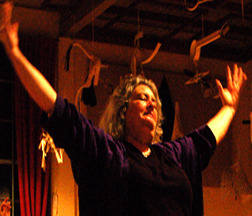
This is how I feel this morning, waking up sixty years old!
But mostly I woke up feeling happy. In sixty years, I have actually learned a thing or two and one of them has to do with happiness—that it's a process, not a destination. I've achieved a fair number of things in life, and received a lot of wonderful things, but what makes me happy is being in the middle of something exciting where I get to work for what I believe in. I love the second and third drafts. The first draft is painful and exhausting—building the architecture of a story, molding the characters and the world out of your own etheric energy. But by the second draft, the story is set, the world has an existence and a reality of its own, and you can just enter into it and enjoy making the improvements.
So now I'm in the second or third draft of life. When you're in your twenties or thirties, you're always agonizing over who you are and what you're going to be. By sixty, life has a pattern. There's some things I'm just not going to be in this lifetime, and I have to let them go. It's too late to have a child, or even to adopt one. That's a big one. I'm not going to learn to do aerial dance, or ski.
But I do have wonderful friends, a loving partner, amazing and talented stepdaughters and Goddess-kids, and I get to do marvelous, exciting things. Write books. Teach permaculture woven together with magic and organizing in Earth Activist Trainings—one starting next week in Quebec! Work with youth and elders in the inner city to grow food in community gardens. And the newest, most exciting project at the moment, the long-time dream that at last is coming day by day more into reality, is making the movie of The Fifth Sacred Thing.
Ever since I posted here and on Facebook that the movie was underway, I feel like I've been getting love-bombed with messages from so many people about how much the book has meant to them. I've had to keep myself grounded by remembering that there are significant crews of people out there that think I'm Scum of the Earth. (The Pope, the Israeli Ministry of the Interior, not a few editors and critics, lots of people who think The Fifth Sacred Thing is hippie drivel, just to name some). It all balances out – but at the moment I'm basking in the sunlight of praise from so many people who tell me that something I've done in those first sixty years has made a significant difference to their lives. Thanks to you all for your posts and comments and good wishes! They mean a lot!
And this week, some wonderful things have happened. So many people have 'liked' our Facebook page—a thrill to see the numbers climb! I've seen the design for the website, which is beautiful, and will be up next week! Kickstarter approved our campaign to raise funds through their website, and we've decided for symbolic and magical reasons to launch it on the Solstice, June 21. Watch for it!
Earlier, I wrote about my long struggles with the screenplay. This week, I got some feedback from a friend who is currently a hot action screenwriter in Hollywood. I quote: "It's frickin' great!" Yes! I've been working a long time for that!
I don't believe that making the movie will make me happy. I'm happy making the movie. Ever since Philip Wood got involved as producer two years ago, I've been happy working on it, knowing there was someone else who shared the vision and who was confident in taking on all the producing pieces I didn't want to do. When Paradox Pollack joined us last fall, he brought a supernova of positive energy into the mix. Between the two of them, they seem to know every creative artist and musician in the known universe, and so many of them have said, "Yes, we want to be involved with this!" Now we also have two amazing women on the team—Alli Gallixsee, who shot our Kickstarter video and is coordinating the social media. One thing I love about Alli is that every time I write something, she tells me it gives her chills or makes her cry. Praise is good! And Jen Zariat, who seems wired into the electric energy of the internet and who knows all kinds of mysterious things, like which fonts make a movie poster look like a big, blockbuster movie!
Photographers wait to shoot in the 'golden hour', just before sunset, when colors are more intense and faces glow with warm light. Sometimes in writing, it's in the later drafts that little things snap together, small inspirations happen, just the right image surfaces that brings the whole project into focus. Writing The Fifth Sacred Thing, I didn't have the title until someone at Bantam suggested it. When they did, on the last revision, I found the imagery all came together in a whole new way.
I'm looking forward to lots of those moments in these later drafts of life. I know that terrible things are happening all around us, the world is still going to hell in spite of my best efforts, that there will be more protests to go to and more losses to face. But there's a certain class of people that are happy as long as they see some good piece of work in front of them that they can do, and I'm one of them. I hope it will be a long time yet before I type "Fade out." And in the meantime, I'm going to go ice skating—just to prove I still can, and meet friends, look at art, eat cake and enjoy the golden light of these lingering days.
June 8, 2011
Beginning to Make The Fifth Sacred Thing Movie
Dia de los Muertos—2004. Election day. I left home around 6 pm to march in the procession through the streets of San Francisco's Mission District. Kerry was in the lead. I walked with poet Francisco Alarcon to the beat of the Aztec drums, following the cut-paper standards that Juan Pablo Gutierrez creates each year, We blessed the four directions as the Aztec dancers spun, and thousands of people carrying candles, dressed as skulls and skeletons or simply in black, paraded past fabulous altars.
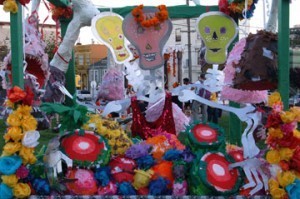
One of the many beautiful altars at San Francisco's Dia de los Muertos celebration.
Dia de los Muertos—the mix of ceremony and celebration, the Latino tradition that now draws in people of all races and religions and cultures—to me it's the essence of the vibrant life of the city that inspired me to write The Fifth Sacred Thing many years ago. I wanted to imagine a world where the values that were most sacred to me—balance with nature, justice, respect for our human diversity, art and pleasure and love—were the basis of society. What would it look like, feel like? How would we live in that world? And how could we defend it against those who still put their trust in brute force and violence?
As I walked, I began to have a bad feeling, as if the tides of fate were shifting, and not in a good way. When I got home, Bush was in the lead. I had a sick feeling in the pit of my stomach—not so much because of who was winning but because of what the whole nasty process with its lies and attacks and voter suppression, if not outright fraud, said about who we are and what our future was likely to be. And a little voice in my head said, "Maybe it would be a good political act to get your book made into a movie."
I'd often thought of getting the book made into a movie—practically everyone who has ever read it has said, "This would be a great movie!" But selling books to the movies is a process fraught with dashed hopes and broken dreams. Most of the time, it means the writer sells the rights and loses all control. Rarely if ever does the writer of a novel write the screenplay—partly because it Is a whole different skill set.
I'd had a couple of options on the book at various times that never turned into a movie. But now I decided I wanted to write the screenplay myself. After all, I had spent a year in the graduate film department at UCLA, and won a major writing prize. Okay, that was in 1972, but still. Besides, I had that magic thing so many writers want and don't have—an agent in Hollywood. Never mind that every time I sent him a draft of the screenplay he responded with, "It's not working—but I'm no good at giving feedback, I can't tell you why." I got lots of helpful comments, mostly on the order of, "Have you thought of getting a real screenwriter to do it?" But I am nothing if not persistent. My mother used to tell me that when I was just learning to walk, she watched me one day trying to cross a threshold, tripping, falling, getting back up, tripping again, falling, over and over. Perfect preparation for writing the screenplay—although perhaps simply beating my head against the wall would have done it.
Just when I had about convinced myself the whole thing was an addictive obsession more than a creative project, my stepdaughter Juliana put me in touch with a friend of hers that she said had always dreamed of making the movie of The Fifth Sacred Thing. Philip Wood–known to his friends as Mouse–had been working in film and music production in the Bay Area for many years and was starting his own production company, Yerba Buena films. We met, and I liked his vision for the movie. He actually liked the screenplay. We talked, we negotiated, gradually we began to scheme, and over time and a few more drafts, somehow "He wants to make this movie" shifted to "We're making this movie." If I wanted to have some impact on how the movie turns out, I needed to be part of it, and Philip was willing to have me.
Then, in October, an old friend posted on my blog that he had finally read the book and was possessed by the need to make it into a movie. I knew Paradox Pollack as what I thought of as The Mysterious People in Black who would show up at 3 AM at our New Year's Eve parties and do contact improv in the attic long after I went to bed. He's an actor, circus performer and dancer who had moved from Bohemian San Francisco scene and been working in Hollywood doing movement choreography for big, feature films for the last six years, including Star Trek, I Am Legend, and Thor. (We call him The Guy Who Taught the Gods How to Move). . When he came on board, our pace revved up. Now, besides doing the dull and necessary things like getting legal and financial structures together, we started to get art, costume ideas, visuals to help shape the look of the future. And the movie has begun to generate its own magic—all kinds of amazing, creative, incredible people have said, "Yes, I want to be part of this!" "Use my art", "Play my music", "How can I help?"
For me, the contradictions inherent in this project are huge. I'm far more at home on the barricades protesting corporate greed than inside a meeting room trying to raise staggering amounts of money. The average cost of a big feature with special effects is something like 100 million dollars. I have to practice saying it without either laughing or flinching. How could I possibly get involved with the money forces on that scale and keep any shreds of integrity? How could we justify the amount of energy and resources it would take?
Well, what if all those resources could be used to help create pieces of that future we want to show in the movie? What if we applied permaculture principles to the making of the movie itself? I wrote up a Green Plan for the production, thinking of all the ways we could not only make the production itself set a whole new standard for ecological filmmaking, but also generate resources that could be left in the city afterwards and provide a platform that could inspire people to start building that beautiful world back in their own home towns. People loved the vision of Avatar so much that many of them dressed up in blue and went out to the woods to play Pandora. Well, The Fifth Sacred Thing is a bit like Avatar on Earth—and if people like the vision they'll see, they can create it right here, and we can provide blueprints on the website! And the Green Plan, it turned out, was inspiring to some of the people who can help us make it happen—from Green Businesses to a fan of the book who now works in San Francisco's Department of the Environment.
So, where are we now? We've got structures for the legal and financial stuff, although there's always endlessly more of those to put in place. We've got artwork, character drawings, wonderful support from major artists who will allow us to use their work and images. We have that screenplay—finally down to the size it needs to be! We have a letter of interest from Olympia Dukakis, who is my dream choice to play Maya, the old woman/storyteller. Within the next couple of weeks, we'll have our website up and already our Facebook Page is up. Please check it out and Like it if you can!
We're just about to take that big leap, from the The Fifth Sacred Thing movie project being my Secret Dream to becoming a Big, Public Dream. Really scary—on so many levels. But as we say, "Where there's fear, there's power." And it's so, so exciting!
What we don't have—yet—the major financing. But—we have a plan! To get together the full packet of legal and creative stuff that will allow us to go after the financing, we need seed money. So we're going to start with a Kickstarter campaign—there will be updates here, on our Facebook page, and you can also go onto my website and sign onto my mailing list. Kickstarter is a website for crowd-funding creative projects. If we can raise at least $50,000, and hopefully more, on Kickstarter, that will get us a big step forward toward pulling together all the pieces we need to go after bigger funding. And equally important, it will show potential investors that there is big support and interest out there for this project. The more we can put together, the more likely we can attract financing from people who will be excited by our vision, and who will want to support it and augment it. (As opposed to what usually happens, where the financial people want to control the vision and generally change it.)
I feel so much responsibility to everyone who loves the book. It's terrifying to think that we might disappoint people. We could fail to make the movie—most movie projects are stillborn before they ever get made. We could make a lousy movie! But I so strongly believe that the world needs a positive vision of the future right now. I can't think of any movie that projects a positive vision of a future here on earth. How can we create it if we can't envision it? A friend confessed to me the other day that she and everyone she knows thinks it's already too late, that we're past the point of no return. I don't believe that. I believe that the earth is resilient and creative—and we are agents of that creative force called to reinvent our way of life right now. If we can give people some hope, some direction and some inspiration, it seems worth all the risks and the work!
Besides, I so want to see those Four Old Women tear up the streets!
You can order the book, and the prequel Walking to Mercury, on my website:
http://www.starhawk.org/writings/fifth-sacred-thing.html
May 18, 2011
Bayview Project in Pictures
So many of you were generous in supporting our work this year in Bayview Hunters Point, teaching permaculture and organic food production to young adults and elders from public housing. I've been wanting to share these pictures for a while–finally I have enough of a break from writing deadlines to upload them. Thanks to all of you who donated so abundantly to Earth Activist Training– http://www.earthactivisttraining.org/.... Your support has made all of this possible!
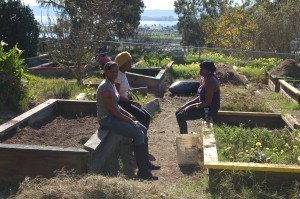
Taking a break at the Adam Rogers garden.
We were working with two gardens–one at Adam Rogers park which had gotten very overgrown with Bermuda Grass. The garden is worked by at-risk middle-school age girls from the Girls 2000 program run by Hunters Point Family www.hunterspointfamily.org.
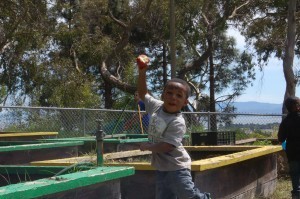
A moment of joy in the garden!
We've had two volunteer days this year so far–one with folks from Earth Activist Training and Hayes Valley Farm, and one organized with a bunch of civic action groups coordinated by Public Allies.

Planting seedlings.
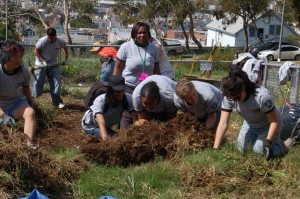
Digging up the Bermuda grass and rolling away the turf was hard work!
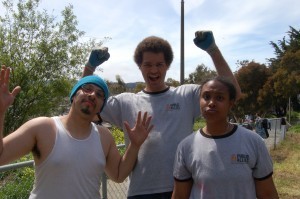
Victory over the Bermuda grass--for the moment!
Charity is too shy to let me take pictures of her, but when I loaned her my camera she got great shots of her friends. She's got a good eye–and it was the first time I'd seen her smile! Kids respond so well to the chance to be creative. Here's some of her shots:
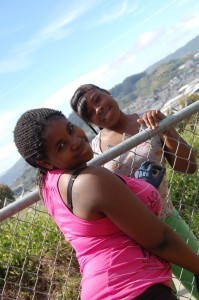
Torrie and Chezless

The girls are great!
LaDiamond is the coordinator of the Adam Rogers garden–and sometimes she brings her boys who are 3 and 5.
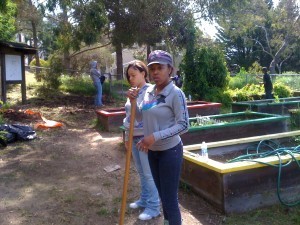
LaDiamond--our coordinator.
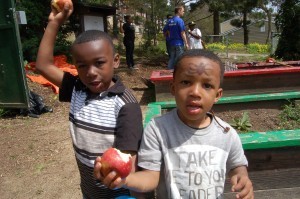
LaDiamond's boys.
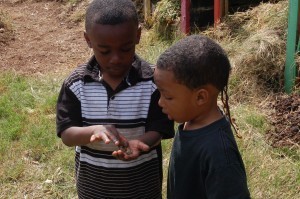
Brothers!
Most of the time, however, the course met at the Alice Griffith Garden in the Doublerock public housing development. We did most of our hands-on projects there–and some of them are shown here in earlier blogs. But we also took field trips–like this one to Hayes Valley Farm, an amazing community garden project built on an old Freeway offramp. Miss Jackie, who coordinates the Doublerock garden, especially liked the raised beds and the great greenhouse. Hayes Valley Farm has also started lots of seedlings for us.

Jay from Hayes Valley Farm and Miss Jackie.
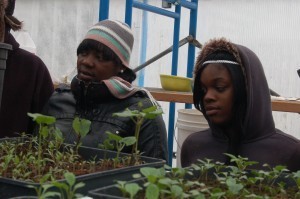
Tiajuana and Mystique in the Hayes Valley Farm greenhouse.
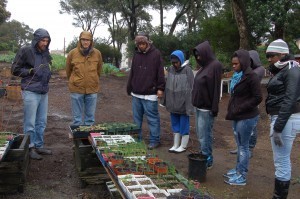
Lots of seedlings at Hayes Valley Farm!
We made a cob bench at Doublerock–I couldn't get any of the guys to take off their shoes and stomp the cob…

Stomping cob with shoes, covered with a tarp!
But LaDiamond did–she got down, dirty and barefoot!
Artist Charles Dabo came and talked about growing up in Senegal, his education and traditional rites of passage.

Charles Dabo, artist and educator.

Got Grease!
And then there was our trip to Got Grease–where they collect used grease from San Francisco restaurants and prepare it to be made into biodiesel, which now runs our busses!

Vats and vats of grease....
And all the students did designs…it was great to see them focused, creative, and learning…everyone was proud of their designs! Again, gratitude to all of you who have helped to support this program! Blessings, Starhawk
May 17, 2011
A Maypole in Prison

Patrick McCollum unloading the Maypole
"When Pagans get their rights, everyone gets their rights," say Patrick McCollum, who for the last fifteen years has volunteered to serve as a Pagan chaplain in the California prisons. McCollum, a talented jewelry designer and craftsman by nature, has in the last decade spent the bulk of his time—and money—helping prisoners and making interfaith alliances worldwide.
This last weekend was the second time I've gone with him to visit women's prisons in central California. Valley State Prison for Women and Central California Women's Facility are across the street from one another out in the fields near Chowchilla. Bland, concrete structures, they look a lot like my junior high school had its chain link fences been topped with razor wire and surveyed by guard towers.
Being in prison is like being in a hellish version of junior high school—where your every movement is monitored and controlled, subject to the prison version of a hall pass, called 'duckets'—a word which I find extremely irritating for some reason, maybe because I suspect it's really supposed to be 'dockets'? I don't know—of all the humiliations and assaults of prison it's probably the least significant, but still it bugs me.
Although I've been arrested and jailed numerous times for political actions, I've never served time in prison. "Short time is hard time," one of the lifer women told me. When you're in for life, or for a long time, as many of these women are, something happens to you. Your ties to the outside world fade, and the prison becomes your world. You let go of the hopes and dreams you once had, and find new, smaller things to hope for within the narrow world to which you are confined.
All the more reason why these celebrations and moments of spiritual commitment take on a greater importance, here, than they do for us outside. When we have infinite opportunities to revel in flowers or dance on the grass or connect with those who share our spirituality, we get blasé. "Maybe I'll go to the ritual—maybe I'll stay home and watch kitty videos on YouTube."
In prison, if you're Pagan, you might get a chance to connect once or twice a year. If you are Christian, of course, there are weekly services, Bible study groups, special programs, Christian Alcoholics Anonymous meetings—but if you're Pagan, your religious rights to meet, to study, to learn about your tradition, to celebrate your holidays and practice your tradition are not generally respected. Patrick and others have fought major battles to gain the limited access we have, and although he is recognized as a chaplain by the State of California, he still has trouble bringing in ritual supplies, books, or volunteers.
I went with Patrick and Johanna and Tiki from the Pagan Alliance. http://thepaganalliance.org/. To get down to Chowchilla by 9 am, we need to leave the Bay Area by 6 am, which means waking up at something like 4:30 am, which is something I try never to do. I don't take 6 am planes or go power jogging before dawn, and I'm not one of those writers who like to work in the wee hours of the morning. Back in the '80s, when we were doing some of those political actions mentioned above, we'd wake up at 4 am to get into place to blockade early workers at nuclear plants. Since then, I've grown to favor actions that start at noon. But waking up that early is inextricably linked, in my mind, with going to jail, still, so it seems appropriate.
At VSPW, they have 'lost' our paperwork, which Patrick has dutifully submitted and had approved. They've also moved us out of the gym and field so they can set up for a Christian group's dedication of a new, interfaith outdoor chapel which is still days away. However, the warden showed up and intervened, not only putting us back in the gym but actually helping to carry in the Maypole! (Which Patrick has constructed from plastic pipes, so it's light.) However, while 160 women have asked to come to the ceremony, only about forty actually have gotten their duckets and been allowed to come. There are a surprising number of Pagans in prison—Patrick estimates something like 20,000 in the U.S. Most of them become Pagan while they're incarcerated. While the numbers of Christians are higher, the Pagans have some of the highest numbers of active, participating members of any religious group—and are among the least served, with no paid chaplains and endless barriers for volunteers.
For me, it's especially heartbreaking to see so many women locked up for life, or for very long sentences. Many, many of them were arrested as teenagers and tried as adults when they were sixteen or seventeen years old—a practice which is, in my mind, itself criminal and unjust. Teenagers are not adults and do not yet have adult understanding—not just of their actions and consequences but also of what their rights are, how the legal system works and how to negotiate it. The most common reasons they're there are drugs, getting caught up in their boyfriends' drug deals and attacking or killing a pimp or a rapist. They end up with heavy sentences, sometimes, out of loyalty—they won't rat out the boyfriend while the men have less compunction about throwing the women under the bus. In prison, boyfriends and husbands generally stop visiting after around six months. Women connected to male prisoners visit them for years.
The women themselves created our ritual. They asked me to invoke the Goddess, and I called in the She Who Blesses All Forms of Love. One reason prisoners embrace Paganism is that we accept people as they are. We think sexuality is a good thing—including gay sexuality, and we tell people that they are children of the Goddess, who loves them even if they might have messed up badly at some point in life. Even in prison, you can continue to grow and develop spiritually, to serve the Goddess and to serve the community. And a number of the women have stepped up to learn how to create and priestess rituals.
We set up the Maypole in the center of the running track. After some time spent untangling the ribbons, which the wind had whipped into a tangle, we danced. I had to sit down for a while—between the blazing heat, the early morning, the lunch of Complete Carbohydrates—veggies and dip, French fries, a biscuit and cake—I was having a bad blood-sugar moment. It was beautiful to watch the dance, however, and see how much the women enjoyed it—the hilarity of moving in and out, under and over, mostly getting it slightly wrong but nonetheless the ribbons weave. Then it was time to go.
Between the heat and the stress, we were nearly comatose by the time we got to our hotel. We went out for Mexican food with Sister Mary Ann, who is the Catholic Chaplain at CCWF, where we were going the next day. Sister Mary Ann is a true Christian—dedicated to the women and the work, selfless, and very supportive of Patrick and all our efforts. She reminded me of the many wonderful nuns, priests and ministers I've met through the years, especially when I was teaching at Matthew Fox's institute back in the '80s and '90s. We may hold different beliefs, but we share common values.
But our visit to CCWF did not go well. Again, they had 'lost' our paperwork—this time, five separate copies of our event package which Sister Mary Ann had personally delivered to five separate officials. The warden was not on site on a Saturday—nor were other personnel who could have okayed the event. The Watch Commander, who could have authorized it, said "No way." We were allowed in as visitors—which meant a much more exhaustive process of listing every single thing we were wearing or carrying. Tiki's underwire bra would not go through the metal detector, and she had to go out, change into a bathing suit, and put up with snide comments about her breasts. But, we got in, though Patrick was quietly fuming while being ever so polite to everyone.
We met in the Chapel, where about twenty of the sixty or so women who had asked to come were assembled. The group at CCWF had been much, much larger—but the prison had systematically transferred out anyone whom they identified as a Pagan leader, so it's now slowly recovering. We weren't allowed to bring in our Maypole, our flowers or any of the ritual food we'd brought, but we had ourselves.
We set up a simple altar with materials on hand, and I led a grounding and taught some basic energetic exercises. We talked with the women and had time to do some counseling one on one, while four volunteers went to get our lunch from the food service.
Then suddenly we got word that the Watch Commander had stopped our food volunteers and sent back the carts, while throwing three of them into Administrative Detention—'the hole'—for doing what they'd been asked to do. Sister Mary Ann was now in trouble for supporting us, and we needed to go before the rest of the women also got into trouble. While Christians get rewarded for attending their services, and their faith is a mark in their favor at parole hearings, Pagans run huge risks. They can get written up, they are often threatened or persecuted, and their faith can be used against them in parole hearings and earn them years more jail time. Nevertheless, they still come.
So we left, going back out through the succession of control points and sally ports. At the visitor's gate, we had to confirm that every single earring and hair ornament we'd brought in was accounted for. Unfortunately, one of us had lost track of her Chapstick. That resulted in frantic calls back to the chapel—and Patrick eventually went back in to find it while we waited. He came back, at last, triumphantly bearing the 'contraband', and we got out. Luckily, one of the chapel clerks had found it—just as the Watch Commander was about to order the guards to put us all into Administrative Detention until they 'investigated' the incident.
The world always looks brighter when you get out of jail—even after a short visit. But any encounter with the system always makes me angry. I'm angry at the discrimination Pagan prisoners face, and I'm even more angry at the system as a whole, which targets poor people and people of color so disproportionately. The prison industrial complex has become a profit-making industry, a new form of slavery. Instead of rehabilitating and reintegrating offenders, it creates a permanent underclass. Draconian sentencing laws, the 'War on Drugs' which is really a war on poor people who use drugs, especially people of color, the whole punitive orientation of our society means we in the U.S. imprison more people than any other country in the world.
Fighting for prisoners' religious rights is just one small way to challenge some of the injustices inherent in the system. Patrick has been carrying the ball for many years now, and has spent tens of thousands of dollars of his own money doing it. He has important court cases making their way upward through the system. Check out his website, below, and if you can support him with a small donation, that will be a huge help.
When Pagans get our rights, everyone gets their rights!
Patrick's website:
http://www.patrickmccollum.org/

Patrick and I taking the Maypole off the truck

Tiki and Johanna from the Pagan Alliance

Listing all our ritual supplies.
March 29, 2011
What Can and Can't Be Fixed
I swore off blogging until my book was done. Which was kind of a shame, because so much has happened in the last two months—social and geological earthquakes, political and real tsunamis, nuclear meltdowns—things about which I have much to say. But I exerted discipline. Dial 1-800-blognomore and hear a cheery recording reminding you of why you should pay some attention to your family and your day job.
Unfortunately, I couldn't swear off vehicular breakdown. So, yesterday, as I took a little break from the fussy work of trying to make sure all the footnotes were correctly numbered (so challenging when you keep moving sections around) my neighbor Jim came over to help me move a big trailer out of its resting place, so that the guys who are moving on could move out their dead truck. Or rather, before Jim came over he called me to say his battery was dead, so I hopped into the truck and went over to give him a jumpstart. Then we headed up to the old cabin on the ridge on my land, so we could dig out the fifth wheel hitch. This is a big double A-frame of metal that fits on rails on the truck-bed and in held by big slide-in bolts with pins in the end. After moving about ten big hog panels we dug out the hitch and successfully attached it. Then Jim noticed a belt was hanging down from the front of my truck.
I had actually noticed that belt the night before, and then forgotten about it when I rushed off to give him a jumpstart.
Now, my inclination was, let's tuck it out of the way, move the trailer and then worry about it. After all, the truck was running.
But Jim, though he has dreadlocks and worries about global conspiracies, along with being one of the sweetest guys in the known universe has a more orderly mind. He wanted to look under the hood. Me, I try at all costs to avoid looking under the hood. I once got my finger caught in the hood of my Toyota, back in about 1971 when I was trying to be a good feminist and learn all the guy things even though they make your hands greasy, and the car had stalled on the freeway out in Pasadena and I was stuck there by the side of the road for over an hour trying to attract someone's attention one-handed while tethered to the front of the car, and trying not to think about how my mother always told me never to get out of the car in the first place because predatory rapists prowl the freeway looking for hapless women victims with car troubles.
Jim ascertained that the belt was the fan belt. He thought pinning it up and ignoring the problem—my proposed solution—was probably a Bad Idea. I was willing to give up using the fan—but he said it ran a couple of other vital things, like the generator and the water pump. But mostly, in spite of the fact that we were on top of a bare hill in the pouring, freezing rain, he was engrossed in the puzzle of how to put the belt back on. We spent a happy quarter of an hour—more happy for him because he had rain pants on while I was getting soaking wet—trying to loop it this way and loop it that way until finally Jim admitted that the problem was beyond him.
So we went and got Jay. Jay lives in the little A-frame house further down the ridge and is known in these parts for his consummate skill with engines. Jay and his partner Judy were cozy by the fire when we came in, dripping, and Jim opened the conversation by merely asking for advice. But after a moment Jay, the Mother Teresa of auto repair, said, "I'll get my jacket and follow you up."
Here's where I made one of my two Helpful Contributions. When Jay asked if we needed a light for the engine, I said, "I don't have much in the way of tools." "I'll get my trouble kit," he said.
We drove back up the hill, and he and Jim opened the hood again, and peered happily in. The gusts of cold rain had turned to a steady, driving sleet and my jeans were soaked through, but if the Selfless Saints of truck repair are staring at your engine, you kind of feel like you should stay with them for moral support, even though you know absolutely nothing about what they're doing.
But here's where I made my second vital contribution—I noticed a sticker on the bar of the hood thingy that had a diagram on it of how the belt was supposed to go. Oh blessed people in the Dodge factory! Some brilliant person, a veteran, perhaps, of his or her own truck breakdowns, had realized that someday, someone might be stuck on a freezing hillside in the rain with a fan belt that had popped off, looking for guidance, and here it was, just where it was needed!
Then I stood, for nearly an hour, getting colder and colder, watching Guys being Guys, oblivious to cold and rain, happily engrossed in the puzzle, saying things like, "The stop on the automatic adjuster appears to be extended to the maximum" and "That pin needs to slot into that hole there," and "The rotor appears to be too high in relation to the pendulum". Jim lay under the truck on the cold ground, Jay pulled out wrenches and unbolted vital parts of the engine and I smiled and nodded and murmured encouraging things while thinking about hypothermia.
Did I mention that I have The Cold—you know, the one that everyone has that goes on for weeks? It's an admirable cold in many ways, one that should be an inspiration to us all, a sort of Republican cold for even when it's defeated and discredited it doesn't quit, but soldiers on, creating low-level misery and scheming for a comeback.
Cold, wind, and sleet did not daunt Jim and Jay, but finally I gave up, begged off and went down to Luan's yurt below the cabin to stand shivering by the woodstove and drink hot tea. I was feeling rather dismal, because it seemed that at best, I'd be spending the next day, after finishing my book, hopefully—driving around the county trying to get truck parts, instead of having a well-deserved day off.
But finally I had thawed enough to trudge back up the hill. Much to my surprise, I was greeted by happy smiles from Jay and Jim. They had discovered the underlying cause of the belt problem—and it wasn't, after all, a stretched-out belt or a shot tensioner, but apparently the whole thing had been installed wrong to begin with. It was like CSI—Truck Repair. Now we could go after the criminal who had caused the problem, maybe years before. Meanwhile, they'd reinstalled it and the truck was running fine. Jay even took the time to show me what to look for when I open the hood to check the oil—which I do force myself to do periodically—so I could tell if the fan belt was at the right tension and if it had stretched enough to need replacing. I've noticed this before—that guys who are good with engines like to explain things to you, and although, as I've noted, I know next to nothing about auto repair the one or two things I do know have all been shown to me by helpful guys in the pouring rain. Given enough time, and the increase in precipitation predicted to follow global warming, probably even I could learn to do a tune-up.
The sun came out, as if to celebrate our victory, and pledging my undying devotion to Jay, Jim and I went on to move the trailer.
But reflecting on these events, it occurred to me that the guys and I live in different realities. Jim and Jay, attuned to machines, believe that there are logical causes for things and that they can find those causes and fix things.
I, on the other hand, believe that there are mysterious forces at work beyond my comprehension, that machines are inhabited by evil or beneficent spirits that need to be placated, and that no matter how well you build something, it will inevitably break down.
I'm thinking about that as I read posts about the ongoing melt-downs at Fukushima in Japan and as my friends organize to protest the Diablo Canyon nuclear power plant's application for relicensing. Thirty years ago, we did our best to prevent Diablo from going online. We blockaded the plant for nearly a month, and there were five thousand arrests, one of the largest nonviolent direct actions of its kind. I got arrested twice—and formed some life-long friendships, learned a whole new style of directly democratic organizing, and became a dedicated anti-nuclear activist. Many of the people up here in these hills took part in that blockade, or the ones that followed against nuclear weapons at the Livermore Weapons Lab or Vandenberg Airforce Base.
At the end of the blockade, an engineer who had worked on the twin plants came out with a revelation—the two plants were mirror images of one another, and at some point, blueprints had gotten mixed up and parts of each had been built backwards.
That is just the sort of thing I would do if I were building nuclear power plants, which thank the Goddess I am not! It took them another four years to straighten the mess out. But the plant did finally go online, although our sustained opposition to nuclear power prevented another fifty plants from being built in California.
The authorities assure us that Diablo is safe, although it is built on an earthquake fault, on the ocean like Fukushima. PG & E, our utility company—the ones with the exploding gas pipes in San Bruno—swears it is safe. Of course, it turns out that some key safety systems have not actually been working for about a year and half, but no one noticed. It seems that they, like me, avoid looking under the hood.
Plants are built by guys—and probably now some gals—who are good with machines. They believe the world is logical, orderly and they have a handle on it. They believe that they are in control.
And no one can deny that their picture of reality is correct. It works. It gets the truck fixed.
And yet, my view of reality is real, too. There are forces out there beyond our control. Earthquakes, tsunamis, floods, disasters—mysterious intersections of causality and sheer dumb luck, or lack of it. I may now know how to check the tension on my fan belt, but that doesn't mean I'll remember to do it. We may have every backup system in the world in place, but that doesn't mean that technicians will maintain them or that they won't all fail, one after another, when Mother Nature unleashes the Big One, as surely in time she will.
Without the water pump, my truck's engine could seize, and that would be a disaster, for the vehicle, potentially for me or a few others. But a nuclear power plant, without its pump—we're talking about hundreds of millions of people affected, land made uninhabitable, a disaster that goes on for ten thousand years.
No one, no technician with an orderly mind, is ever going to convince me that's safe. It's not safe. By its inherent nature and the way the universe works, it cannot be made safe. To think it can is the ultimate hubris. Even now, there may be particles of poison from Japan in that driving rain.
Stop building them. Shut them down. Do not, under any circumstances, extend the licensing of 'diablo Canyon: an aging plant on an earthquake fault run by a company with a horrific safety record. Nuclear power is not the answer to global warming—its a new level of disaster waiting to happen.
Take the billions Obama wants to put into nukes and build new wind generators and solar panels and hire kids from the inner city to install them. Use that research money to solve any problems with renewables—and I guarantee we'll have a renaissance of clean, abundant energy that can bring us all healthful and fulfilled lives without burning coal, fossil fuels, or living with the shadow of nuclear wasteland hovering.
I am so grateful to Jim and Jay, and all the guys and gals who come out in the freezing rain to fix things. To those brave technicians risking cancer and horrific deaths to cool the nuclear monster. To all who labor to repair the world's ills.
But some things can't be fixed.









